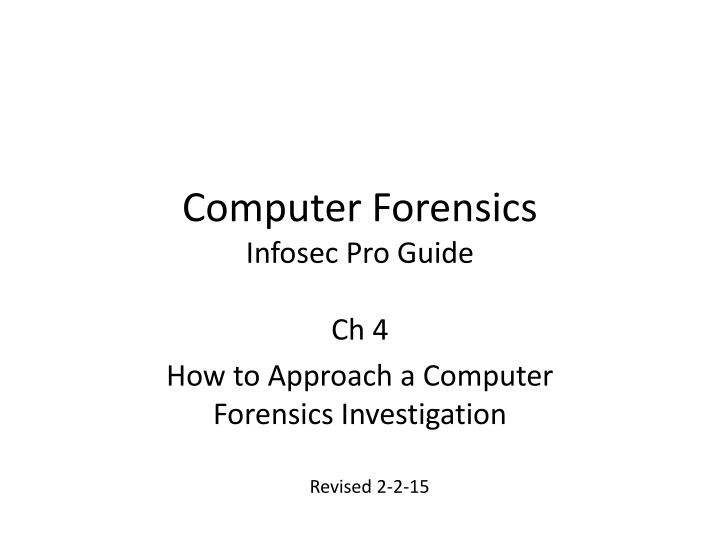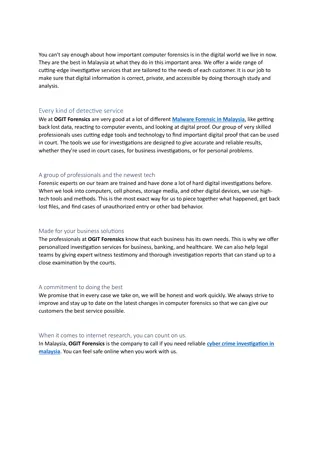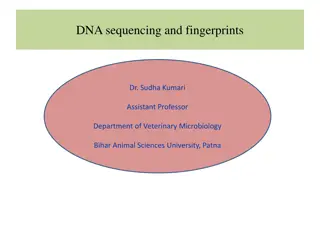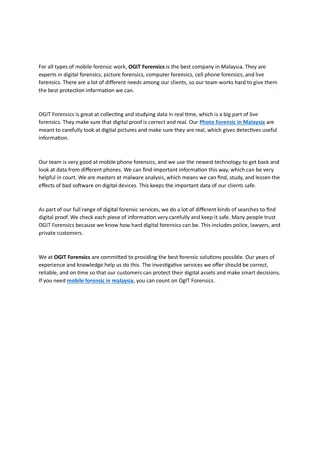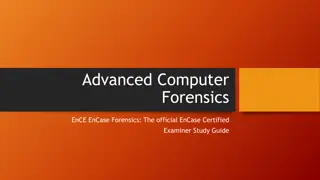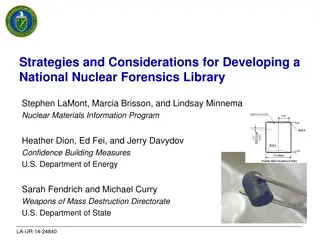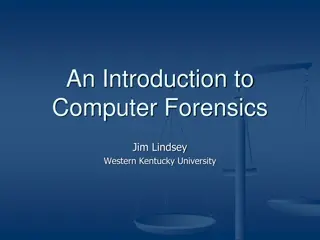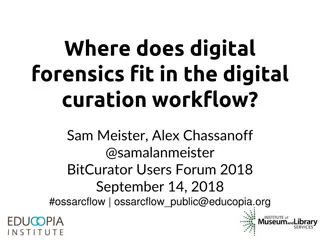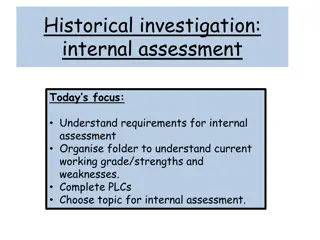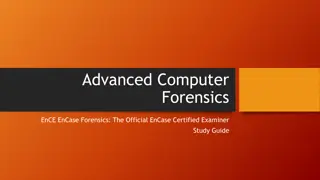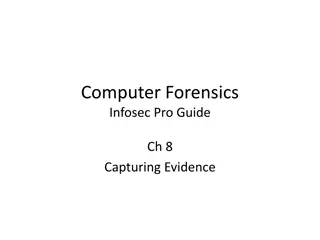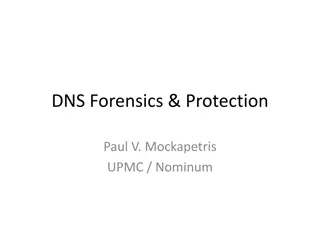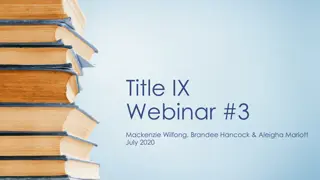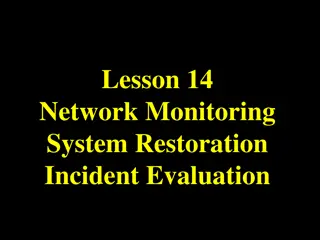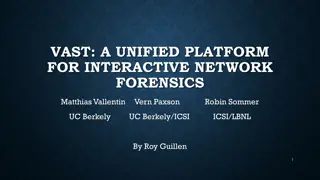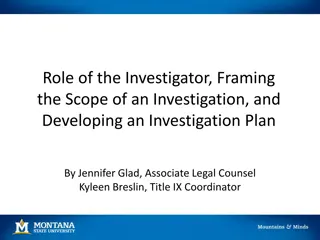Digital Forensics Investigation Process Overview
Explore the essential steps and considerations involved in approaching a computer forensics investigation, from testing hypotheses to assessing available data sources and seeking appropriate authorization. Learn about data carving, handling sensitive issues like child pornography, and the importance of clarifying investigation boundaries with the requesting party.
Download Presentation

Please find below an Image/Link to download the presentation.
The content on the website is provided AS IS for your information and personal use only. It may not be sold, licensed, or shared on other websites without obtaining consent from the author.If you encounter any issues during the download, it is possible that the publisher has removed the file from their server.
You are allowed to download the files provided on this website for personal or commercial use, subject to the condition that they are used lawfully. All files are the property of their respective owners.
The content on the website is provided AS IS for your information and personal use only. It may not be sold, licensed, or shared on other websites without obtaining consent from the author.
E N D
Presentation Transcript
Computer Forensics Infosec Pro Guide Ch 4 How to Approach a Computer Forensics Investigation Revised 2-2-15
Topics Investigative process Testing your hypothesis Assessing the forensic data landscape How to determine what you have authority to access
Basics Target of investigation is a suspect Know what you are being asked to find ou You need authorization to perform an investigation Honey pot is a system designed to attract attackers, so their activities can be monitored
Where Would the Data Exist? Ex: viewing indecent images at work Outbound proxy or web-filtering log Computer used for viewing the images Firewalls logging outbound access What applications might have been used to create the data? Often a Web browser; Chrome, IE, Safari, etc. Should you request to go beyond the scope of an investigation?
Data Carving Reconstructing files from unallocated blocks of data Also called latent data Uses file headers and footers, also called file signatures Active data Files and folders that are in the directory No carving needed to reconstruct them
Should You Request to Go Beyond the Scope of an Investigation? Child Pornography: STOP THE INVESTIGATION You are legally required to notify the National Center for Missing and Exploited Children missingkids.com Also notify your client
Ask the Person Requesting the Examination "If I find an indication of something other than the original action as requested, would you like me to go forward in examining that issue?" Don't assume you are allowed to investigate without approval
Index.dat and TypedURLs Index.dat file contains Internet Explorer history Link Ch 4a TypedURLs is a registry key Contains the last 25 addresses typed into Internet Explorer Link Ch 4b Textbook confuses these two at location 1537
Testing Your Hypothesis: Scientific Method 1. Characterization of artifacts Ex: Index.dat file (IE History) shows forbidden URLs 2. Hypothesis These represent actual Web browsing, not random pop-ups, because they were found in TypedURLs 3. Predictions If I use a test machine and type a URL into the IE address bar, it goes into TypedURLs, but if I just click on a link, it doesn't 4. Experiments
Testing Use a clean virtual machine Get the same version of software the suspect used Document your testing
Computer Forensic Tool Testing Project Link Ch 4c
If you type text into Notepad, and have not yet saved it yet, where can that data be found on the hard disk? A. Latent data B. Active data C. Both of the above D. None of the above
If you save a Notepad file on disk, where can that data be found on that hard disk? A. Latent data B. Active data C. Both of the above D. None of the above
If you move a file into the Recycle Bin, where can that data be found on the hard disk? A. Latent data B. Active data C. Both of the above D. None of the above
If you move a file into the Recycle Bin, and then empty the Recycle Bin, where can that data be found on the hard disk? A. Latent data B. Active data C. Both of the above D. None of the above
If you reformat your hard disk, where can that Notepad data be found on the hard disk? A. Latent data B. Active data C. Both of the above D. None of the above
What type of data requires file carving to collect? A. Latent data B. Active data C. Both of the above D. None of the above
Forensic Data Landscape Active data Unallocated space Slack space Mobile devices External storage
Active data Any nondeleted files or data All files and folders Logs, registry, email archives File system objects such as $MFT Master File Table, used to store the directory on NTFS volumes
Unallocated space Parts of the disk that are not currently allocated to active data Chunks of old data scattered randomly on the disk Can be reconstructed into files with carving But only if the file signature is intact Can be searched for keywords Even if the file cannot be reconstructed
Slack space Portions of a cluster that are not used by the current active file Left over at the end of many files Almost always incomplete Keywords are more effective than file carving for this data
NTFS Volume 4 KB clusters 512 Byte Sectors 8 sectors per cluster The drive controller will only allow a read or write operation to a whole sector The Master File Table will only assign complete clusters to a filename
Example of Slack Save a 10,000 byte file containing "SPAM" Uses 3 clusters SPAM SPAM SPAM SPAM SPAM SPAM SPAM SPAM SPAM SPAM SPAM SPAM SPAM SPAM SPAM SPAM 0 0 SPAM+0 0 0 SPAM SPAM SPAM Delete, save many 1,000 byte files containing EGGS usable slack space data is bold SPAM SPAM EGGS+0 SPAM SPAM SPAM EGGS EGGS SPAM SPAM EGGS+0 SPAM SPAM SPAM EGGS EGGS 0 0 SPAM+0 EGGS+0 0 0 EGGS EGGS
Mobile devices FTK & EnCase can acquire contents Standard Cell Phones Text messages & images & call records SIM card reader can gather a forensic image of the SIM card PDAs and Media Players iPods, MP3 players, PDAs Flash storage with recoverable deleted data
Mobile devices Smart Phones iPhone, Android, Windows Phone, Symbian? Have flash storage and recoverable deleted data Text messages & images & call records Also emails, documents, Internet activity
Mobile Device Specialized Tools Paraben Device Seizure Oxygen Forensic Suite Elcomsoft's iOS Toolkit
Password Protection Blackberries will wipe themselves if too many wrong passwords are entered Some devices have password bypass vulnerabilities You may be able to get the password from the suspect or a corporate administrator
Link Ch 4d Can also get iTunes data from a computer synced to the phone (link Ch 4e)
iPhone 6 data is encrypted with a key based on the user's PIN So Apple can't decrypt it, even in response to a court order CNIT 128, Link Ch 3z10
BUT Apple still has the keys to iCloud CNIT 128, Link Ch 3z11
Tablets iPad, Android tablets, Microsoft Surface Similar information as a smart phone But no call records or SMS
External Storage USB thumb drives USB hard disks CDs and DVDs All appear to be hard drives to OS, so hard disk imaging products work
How to Determine What You Have Authority to Access
Authority Law enforcement authority is defined in search warrant Private investigators get authority from company that hires them Who Hosts the Data? If company owns the server, no problem Cloud resources may not grant the company the right to search the data, or may not grant administrator access to the machines
Imaging Cloud Servers FTK and EnCase can do it, but there are many complications Links Ch 4f, 4g
Who Owns the Device Company-owned is simple: company can authorize a search BYOD (Bring Your Own Device) Personal device used for company business Unclear what rights the company has to search the data on it Need legal advice BUT: if the suspect consents to a search, it's OK
Expectation of Privacy Need legal advice: if company has not warned employees that there is no expectation of privacy, evidence may be inadmissible in court Commonly part of a logon banner
Logon Banner From "Guide to Computer Forensics and Investigations , Fourth Edition", by Nelson, Phillips, Steuart
Privileged Communications Attorney-client communications are not admissible in court "This email communication may contain CONFIDENTIAL INFORMATION WHICH ALSO MAY BE LEGALLY PRIVILEGED and is intended only for the use of the intended recipients identified above..."
Personal Communications Not protected in US unless there is a reasonable expectation of privacy In Europe, data privacy laws require written consent from the suspect to make a forensic image of any system on which he or she may have stored private data
Which item is usually 4096 bytes in size? A. Sector B. Cluster C. $MFT D. FAT E. Slack
Which item records the names of files in Windows 7? A. Sector B. Cluster C. $MFT D. FAT E. Slack
A suspect had all these devices, but smashed them all to tiny bits with a hammer. Which device's data is most likely to be recoverable? A. CD B. Hard disk C. RAM D. iPhone E. USB flash memory stick
Which item removes the expectation of privacy? A. BYOD B. Honeypot C. Child pormography D. Logon banner E. Attorney-client privilege
Which item is intended to attract attacks? A. BYOD B. Honeypot C. Child pormography D. Logon banner E. Attorney-client privilege
Which item removes the burden of discovery? A. BYOD B. Honeypot C. Child pormography D. Logon banner E. Attorney-client privilege
